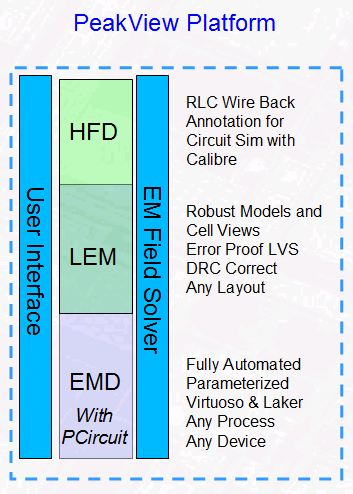 Lorentz Solution presented at TSMC’s DAC 2012 Open Innovation Platform Theater. The presenter was Lorentz Sales Director, Tom Simon. He presented what Lorentz calls its Electromagnetic Design and Analysis Platform. One of the main points of the talk was the cooperative work that Lorentz does with TSMC.
Lorentz Solution presented at TSMC’s DAC 2012 Open Innovation Platform Theater. The presenter was Lorentz Sales Director, Tom Simon. He presented what Lorentz calls its Electromagnetic Design and Analysis Platform. One of the main points of the talk was the cooperative work that Lorentz does with TSMC.
TSMC and Lorentz work together in several ways. TSMC uses Lorentz’s PeakView for designing their RF IP. In addition to working to support mutual customers, there is collaboration on RDK’s and ongoing correlation projects. These projects ensure accurate results on a wide range of structures and devices. Special focus on capacitor structures, and proper handling of metal fills, guard rings, and pattern ground shields yields excellent correlation up through millimeter wavelength frequencies.
Lorentz says that PeakView is suitable for both design use and sign-off, avoiding the “two-tool” solution that many customers live with.
For design PeakView fits in the flow for new device creation with its PCircuit synthesis. Complex devices can be ‘what-if’ed to arrive at optimal tcoil, transformer, balun, tline and cap configurations that best suit the designer’s needs. Multiple devices can be compared side by side in the Device Editor.
Lorentz emphasized that synthesis with PCircuits does not require costly and time consuming EDA vendor set up: no scalable models are needed. As soon as a new layer stack-up is created in PeakView, the full power of PCircuits is available. They say that new and complex devices with high port counts are easily synthesized. There is no dependency on pre-characterization of the process or the cell. Apparently this opens a much larger design space for customers.
PeakView has a new circuit level capacities to electromagnetically model critical interconnections for RC and especially L in the LPE/PEX flow. Complex critical nets are easily and properly analyzed during design iterations, without manual intervention. Simon said the resulting circuit simulation accuracy improves silicon predictability.
PeakView is now also tightly linked to Laker, as well as to Virtuoso. PeakView’s PCircuits, used to create passive device designs, work equally well in both layout editors. PCircuits are process independent and can easily be created to handle new devices. Unlike Pcells, they are compact, object oriented and PDK driven.
Complex hand drawn or PCircuit generated structures can be electromagnetically simulated by PeakView with its fast full wave 3D field solver. Simon added that PeakView allows for accurate and efficient analysis of metal fills, via arrays and other complex structures.
After electromagnetic simulation, compact convergent DC accurate Physics Based Models (PBM) are generated as RLC sub-circuits, in addition to s-parameter output. Process variation and temperature coefficients are supported.
PeakView has built in visualization for viewing voltage, current and meshing. It also features a built in chart window. Its GUI based operation is perfect for increased designer and modeling team productivity.
Bottom line: Lorentz has built a platform for designers and modeling teams that increases creativity and productivity by letting designers create their own geometry and models, and at the same time improving the efficiency of the EM experts with a faster highly accurate solution for sign off model creation. Lorentz’s new capabilities at the circuit level add significant accuracy to high speed analog design.
Share this post via:







Comments
There are no comments yet.
You must register or log in to view/post comments.